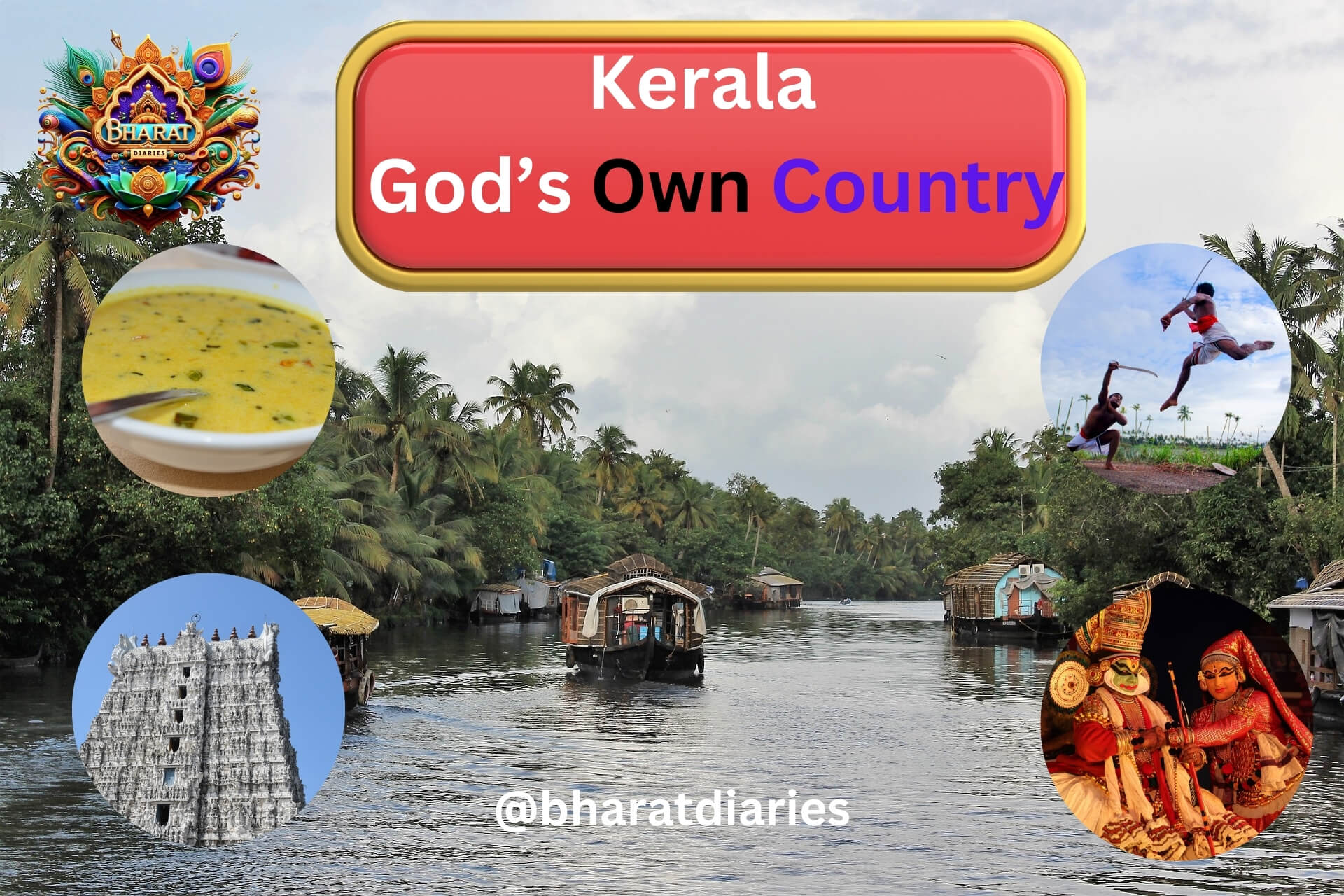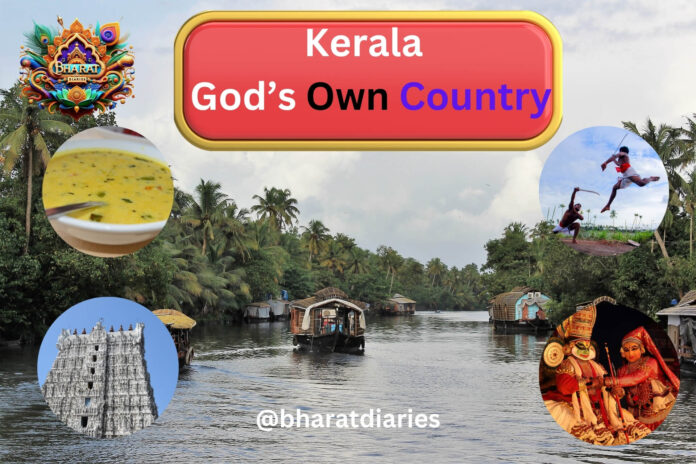
Explore Kerala’s captivating weather, vibrant culture, rich food heritage, stunning temples, and breathtaking tourist spots. Your guide to ‘God’s Own Country.
Table of Contents
Introduction
Kerala is appropriately called “God’s Own Country,” an elegantly packaged treasure house of natural beauty and a rich cultural heritage full of culinary delights. The tourism destination is described as a landmark on the southwestern coast of India. The attractive blend of lush green vegetation, serene backwaters, history and rich cultural heritage commands travelers from all corners of the earth.
From the tropical climate to vibrant festivals, flavorable cuisine, and awe-inspiring temples, Kerala can give you an experience you will never forget. Through this blog, we will take you on a journey through Kerala’s weather, culture, food traditions, famous temples, and must-visit tourist spots. If it is your first trip, or you are re-visiting this enchanting state, the guide has everything for you.
1. Kerala’s Weather: A Tropical Paradise
Kerala is strictly tropical, so it is a year-round destination with clear-cut seasons for summer, monsoon, and winter.
Summer (March to May): Summers in Kerala are warm and sticky, with temperatures ranging from 28°C to 35°C. While it may feel quite warm, the hill stations such as Munnar and Wayanad will keep all the heat at bay.
Monsoon (June to September): The monsoon shall change Kerala into a verdant haven. The rain is heavy yet rhythmic. This is the period when experiencing Ayurveda therapies amidst serene landscapes become ideal.
Winter (October to February): Winter is the perfect time to visit Kerala because of the pleasant weather ranging between 20°C and 28°C. It’s ideal for surfing the beaches, sailing on backwaters, and visiting historical sites.
The generous rains and moderate winters make it easy for Kerala’s rich landscapes, teeming wildlife, and agriculture to flourish.
Bharat: A Tapestry of Unity in Diversity, Cultural Brilliance, and Sustainable Wisdom https://bharatdiaries.com/bharat-a-tapestry-of-unity-in-diversity-cultural-brilliance-and-sustainable-wisdom/
2. Cultural Heritage of Kerala: Weave of Traditions
Kerala culture is the synthesis of various traditions and influence going well with the intensity of its history as well as its multi-cultural society.
Festivals: Festivals like Onam, Vishu, and Thrissur Pooram celebrate the state’s agrarian roots and spiritual beliefs. Onam is the harvest festival celebrated with colorful pookalams (flower carpets), Vallamkali (snake boat races), and the very famous Onasadya feast.
Performing Arts: Kathakali is a classical dance-drama while Mohiniyattam is a graceful dance form of this land, showcasing its brilliance for art. Carnatic music and Sopana Sangeetham are two of the traditional music forms that add a melodic touch to cultural events.
Literature and Cinema: Kerala’s literary legends, Thunchaththu Ezhuthachan and Vaikom Muhammad Basheer, have made invaluable contributions to Indian literature. “Mollywood” is the name for Malayalam cinema, which has become famous for intellectual themes and engaging storytelling.
Culture and traditions of Kerala were centered on the belief of unity in diversity, with aspects of Hindu, Muslim, and Christian traditions merged perfectly.
3. Food Culture in Kerala: A Gastronomical Delight
The combined flavors of coconut, spices, and fresh seafood, Kerala’s cuisine defines an extensive journey into its delectable flavors.
Traditional Dishes: from the symbolic Sadhya to being served on banana leaves to appam with stew, each dish has a story about it. The parotta with beef curry is a treat in itself for non-vegetarians, while avial and thoran can be savored by vegetarians.
Seafood Delights: Kerala’s coastal location ensures an abundant variety of seafood. Karimeen pollichathu (pearl spot fish) and Chemmeen curry (prawn curry) are local favorites.
Snacks and Desserts: Banana chips, unniyappam, and pazham pori are popular snacks, while payasam and ada pradhaman are essential sweet dishes during celebrations.
Influences: Portuguese, Arab, and Dutch traders have left their mark on Kerala’s culinary landscape, introducing ingredients like tapioca, cashew nuts, and exotic spices.
The culinary culture of Kerala is an epitome of its great heritage and natural wealth, and this will make a heaven for a foodie.
4. Tourist Attractions in Kerala: Nature and More
This state has many attractions to its name, from the very peaceful beaches to cool hill stations and soothing backwaters.
Backwaters of Alleppey and Kumarakom: The houseboats give a glimpse into that idyllic village life around coconut groves and paddy fields.
Munnar: A hill station with tea plantations, Eravikulam National Park, and the majestic sceneries of the Anamudi Peak.
Beaches: Sun-kissed Kovalam, Varkala, and Marari beaches perfect to sunbath, water sports, and nature’s spectacular sunsets.
Wildlife Sanctuaries: For the lovers of nature and wildlife photography, Periyar Wildlife Sanctuary and Wayanad Wildlife Sanctuary are a heaven.
Athirapally Waterfalls: Dubbed as “Niagara of India”, this majestic beauty cannot be missed.
Historical Places: Fort Kochi, famous for its Chinese fishing nets and its colonial architecture, and Padmanabhapuram Palace, a showcase of traditional Kerala architecture.
Here has everything in it. Right from adventure to relaxation to something which will enrich your cultural self.
5. Temples of Kerala: Spiritual Homes
Kerala’s temples are architectural marvels and spiritual hubs that attract pilgrims and tourists alike.
Sree Padmanabhaswamy Temple (Thiruvananthapuram): The shrine houses the lavish Dravidian architecture and great treasure in reverence for Lord Vishnu.
Guruvayur Temple (Thrissur): The Lord Krishna temple is said to be one of the most important pilgrimage centers having daily rituals and festivals.
Sabarimala Temple: Located in the Western Ghats, the shrine welcomes millions of devotees primarily during the annual Mandala-Makaravilakku season.
Vadakkunnathan Temple (Thrissur): This Shiva temple is a cultural one owing to the exquisitely painted murals and wood carvings.
Chottanikkara Temple (Ernakulam): This temple of Goddess Bhagavathy is believed to have healing powers.
These temples validate Kerala’s rich architectural skill besides the profound spiritual traditions it has.
6. Kerala’s Cultural Heritage: A Rich Legacy
Of course, Kerala’s cultural heritage goes further than the festivals, arts, and cuisine in terms of traditional medicine, martial arts, and crafts.
Ayurveda: Kerala is the motherland of Ayurveda. Rejuvenating therapies and treatments in Kerala attract wellness seekers from all over the world.
Kalaripayattu: Kalaripayattu is one of the oldest forms of martial arts in the world, which was invented in Kerala. It still lives on.
Handicrafts: Kerala’s coir products, Aranmula mirrors, and Kasavu sarees are renowned for their craftsmanship all around the world.
Architecture: Kerala’s ecological orientation is reflected in the traditional Nalukettu houses with central courtyards.
The state’s heritage is a perfect blend of innovation and respect for tradition; Kerala stands as a beacon of cultural richness.
Conclusion
Kerala is not a destination but an experience to the soul. From its picturesque landscapes and vibrant culture to its delectable food and spiritual havens, Kerala does encapsulate the essence of India’s diversity in a nutshell. Whether it is that cup of chai in Munnar, the dance of Kathakali, or an inclusive ride through the backwaters, all moments in Kerala have that intangible flavor of the unforgettable. So, when planning your journey to this heaven, give the spirit of Kerala a pleasant show and make memories that will last for a lifetime.
